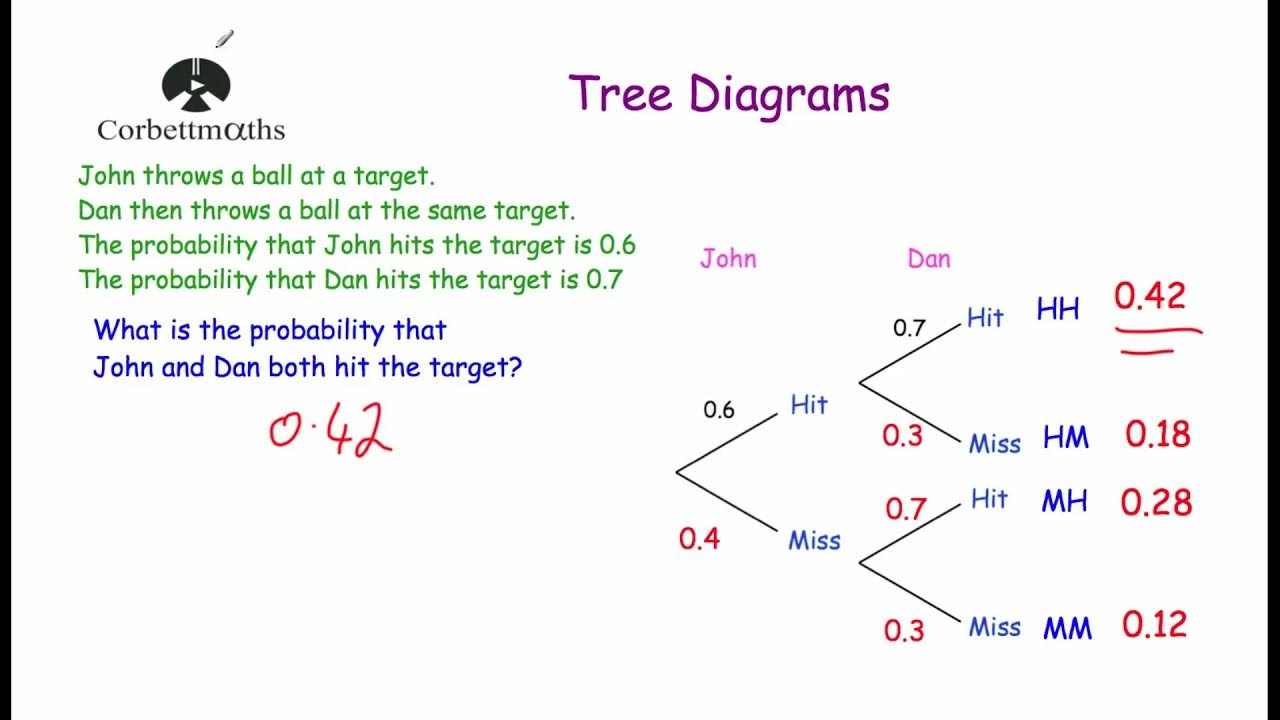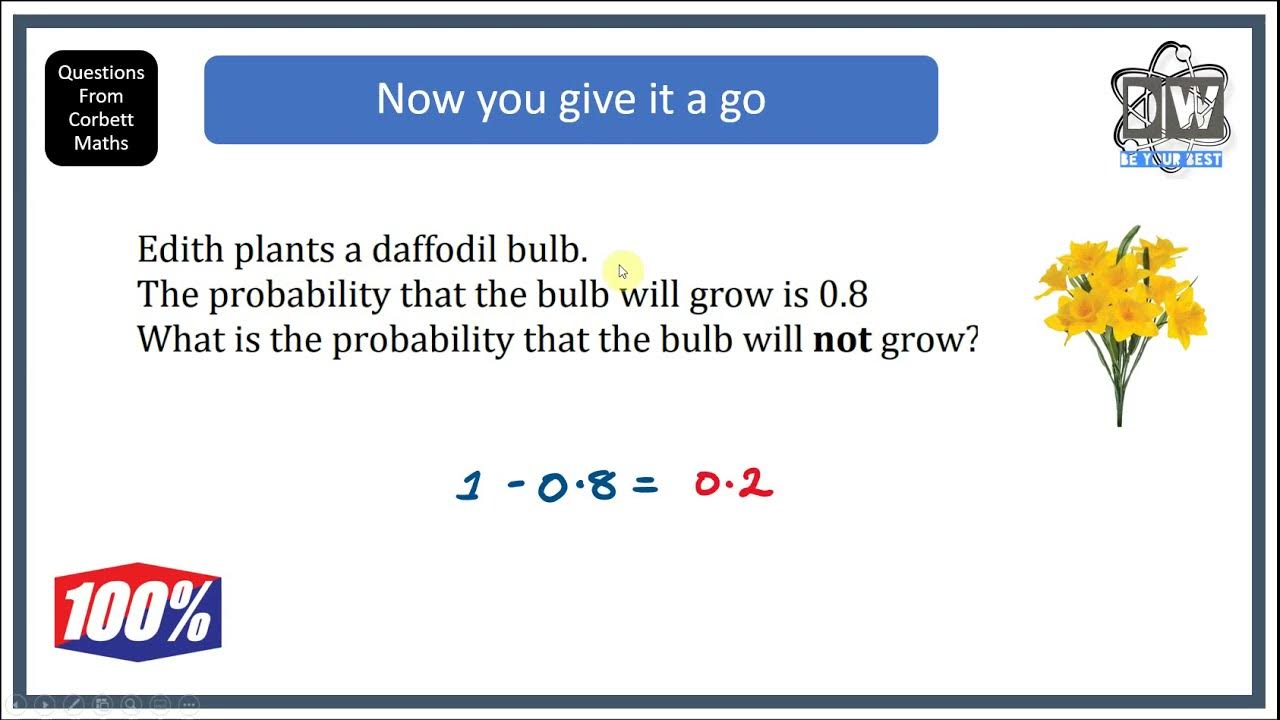Materi Peluang Kelas X Kurikulum Merdeka
Summary
TLDRThis video tutorial explores the concept of probability, focusing on how to calculate the likelihood of events. The presenter covers basic principles such as the probability formula (Pa = Na / Ns), where Na represents the number of favorable outcomes and Ns represents the total number of possible outcomes. Different examples are used to illustrate these concepts, including coin tosses, dice rolls, and combinations of children’s genders in a family. The tutorial also offers step-by-step solutions to probability problems, helping viewers better understand the subject through clear explanations and practical exercises.
Takeaways
- 😀 Probability (P) is calculated using the formula Pa = Na / Ns, where Pa is the probability of event A, Na is the number of favorable outcomes, and Ns is the total number of possible outcomes in the sample space.
- 😀 The value of probability always ranges between 0 and 1, where 0 represents impossibility and 1 represents certainty.
- 😀 Sample spaces (Ns) represent all possible outcomes of an event, while Na represents the favorable outcomes specific to the event being considered.
- 😀 The probability of an event is calculated by dividing the number of favorable outcomes (Na) by the total number of outcomes in the sample space (Ns).
- 😀 When flipping a single coin, the sample space consists of two outcomes: Heads (H) or Tails (T), so Ns = 2.
- 😀 For two coin flips, there are four possible outcomes: HH, HT, TH, and TT, making Ns = 4.
- 😀 With three coins, the sample space expands to 8 possible outcomes: HHH, HHT, HTH, HTT, THH, THT, TTH, and TTT.
- 😀 A die has six faces, and the sample space for rolling a single die is Ns = 6, with outcomes 1, 2, 3, 4, 5, and 6.
- 😀 When rolling two dice, the total number of possible outcomes is 36 (6 outcomes from the first die multiplied by 6 outcomes from the second die).
- 😀 In a scenario with three children, where the gender of each child can be either male (L) or female (P), the sample space for the possible gender combinations is 8, and the probability of having exactly one boy and two girls is 3/8.
Q & A
What is the formula for calculating probability (P)?
-The formula for calculating probability (P) is P = na/ns, where 'na' represents the number of favorable outcomes, and 'ns' represents the total number of possible outcomes.
What does 'na' and 'ns' stand for in the probability formula?
-'na' stands for the number of favorable outcomes (the specific event we are interested in), and 'ns' stands for the total number of possible outcomes (the sample space).
What does it mean when a probability is equal to 1?
-A probability equal to 1 indicates a certainty or a guaranteed event, meaning that the event will definitely happen.
How many possible outcomes are there when a single coin is tossed?
-When a single coin is tossed, there are two possible outcomes: heads (H) or tails (T).
How many possible outcomes are there when two coins are tossed?
-When two coins are tossed, there are four possible outcomes: HH (both heads), HT (head on the first coin, tail on the second), TH (tail on the first coin, head on the second), and TT (both tails).
What is the probability of getting two tails when two coins are tossed?
-The probability of getting two tails (TT) when two coins are tossed is 1/4, as there is one favorable outcome (TT) out of the four possible outcomes.
How many possible outcomes are there when three coins are tossed?
-When three coins are tossed, there are eight possible outcomes, as each coin has two possibilities (heads or tails), and 2^3 = 8.
What is the total number of possible outcomes when two dice are rolled?
-When two dice are rolled, the total number of possible outcomes is 36, as there are 6 faces on each die, resulting in 6 x 6 = 36 possible combinations.
What is the probability of rolling a sum of 7 with two dice?
-The probability of rolling a sum of 7 with two dice is 6/36, or 1/6. This is because there are 6 possible outcomes that add up to 7, out of the 36 total outcomes.
In the context of the script, how many possible gender combinations are there for three children?
-For three children, where each child can either be male or female, there are 8 possible combinations, as each child has two possibilities (male or female), and 2^3 = 8.
What is the probability of having exactly one boy and two girls among three children?
-The probability of having exactly one boy and two girls among three children is 3/8. This is because there are three favorable outcomes (one boy and two girls) out of the eight possible combinations.
Outlines

This section is available to paid users only. Please upgrade to access this part.
Upgrade NowMindmap

This section is available to paid users only. Please upgrade to access this part.
Upgrade NowKeywords

This section is available to paid users only. Please upgrade to access this part.
Upgrade NowHighlights

This section is available to paid users only. Please upgrade to access this part.
Upgrade NowTranscripts

This section is available to paid users only. Please upgrade to access this part.
Upgrade NowBrowse More Related Video

Probability Concepts for Data Analysis and Data Science | Statistics for Data Science

Peluang Kejadian Saling Lepas

Tree Diagrams - Corbettmaths

Probability (Event Not Happening)

(Part 1) PELUANG MATEMATIKA SMA KELAS 10 #kurikulummerdeka #matematikasma #bukupaket

Peluang ~ Menentukan Nilai Peluang dan Frekuensi Harapan Suatu Kejadian (Materi PJJ Klas VIII/8 SMP)
5.0 / 5 (0 votes)